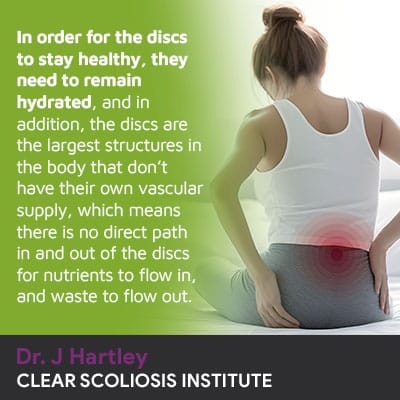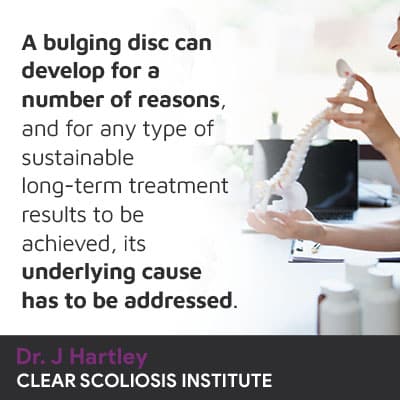
The overall health of the spine depends on the health of its individual structures, like its intervertebral discs. In order for the spine to maintain its natural curves, alignment, and flexibility, the discs have to be functioning optimally. When a disc is bulging, it can affect the spine, its nerves within, and its surroundings.
A healthy spine consists of vertebrae stacked on top of one another in a straight alignment, and adjacent vertebrae are separated by an intervertebral disc. When a disc is bulging, its inner nucleus is bulging outwards, pushing against its outer annulus, and treatment will depend on the underlying cause.
A basic understanding of the spine’s structure is important when discussing spinal conditions such as a bulging disc, so let’s start with some basic spinal anatomy.
The spine is a key structure of human anatomy; not only does it allow us to stand upright and practice proper posture, it also facilitates flexible movements such as bending, lifting, and twisting, protects important organs, and the spinal cord within works with the brain to form the body’s central nervous system.
In light of its many important roles, it’s clear how spinal conditions can cause effects felt throughout the body, and not just in and around the spine.
The spine consists of bones (vertebrae) that are stacked on top of one another, and if the vertebral bodies remain aligned, the spine’s natural curves are in place; the spine’s healthy curves make it stronger, better able to absorb mechanical stress, and more flexible.
The spine’s three main sections include the cervical spine (neck), thoracic spine (middle/upper back), and the lumbar spine (lower back).
Each of the spinal sections has its own curvature type, and the health of each curve depends on the health of the others.
An intervertebral disc sits between adjacent vertebrae, and before getting to the specifics of bulging disc treatment, let’s take a closer look at the structure and roles of the spinal discs.
The intervertebral discs have two main components: a soft gel-like interior called the nucleus pulposus and a tough and durable outer layer called the annulus fibrosus.
The outer annulus is made up of concentric layers of collagen fibers that surround the disc’s inner nucleus; the nucleus contains loose fibers that are suspended in its gel-like interior.
The fibers that surround the nucleus act as a hydraulic seal that coats and protects it, and they also help evenly distribute force and pressure generated during activity.
The outer annulus has two cartilaginous end-plates that give the spine structure as adjacent vertebrae attach to the end plates of the disc in between.
So if a disc starts to degenerate and changes shape as result, it can cause the vertebrae attached to shift their position, and that can result in a misaligned spine.
When we’re born, approximately 80 percent of the discs are made of water, but as we age, that fluid level decreases, with certain lifestyle factors and/or conditions affecting the rate of fluid loss.

Because the discs don’t have their own vascular supply, they are particularly vulnerable to the effects of degeneration, and once degenerative disc disease starts, it can be difficult to reverse.
The discs give the spine structure (vertebrae attach to the disc in between), combine forces to facilitate spinal flexibility, provide cushioning between adjacent vertebrae, and act as the spine’s shock absorbers.
So now that we’ve explored some basic spinal anatomy and the structure of its intervertebral discs, let’s talk about how a bulging disc develops.
In order for the discs to stay healthy, they have to maintain their shape and fluid levels, but what happens if a disc starts to degenerate?
The body degenerates slowly over time, and the spinal discs are no exception, when a disc starts to degenerate, it can become desiccated and lose height as a result.
If you think of the disc as a marshmallow between two cookies, this is a helpful visualization of how disc health and function can be affected by pressure.
If the cookies are squeezed together, the marshmallow in between is being exposed to pressure from above and below, causing it to become compressed, losing height, and changing shape; this is how a disc’s inner nucleus can push outwards against its outer annulus and become what’s known as a bulging disc.
A bulging disc can extend into the spinal canal, through which the spinal cord passes; the spinal cord is a bundle of nerves, and if a bulging disc is encroaching on the space within the spinal canal, nerves are being compressed, and this can cause a number of issues that affect different areas of the body.
Now that we’ve defined a bulging disc, let’s talk about causes and treatment options.

As mentioned, a disc’s fluid level is important, and if a bulging disc has developed, this is commonly due to disc degeneration, aka degenerative disc disease.
As mentioned earlier, while there is a certain amount of spinal degeneration that’s expected as people age, the cumulative effect of a number of lifestyle factors can play a role in the severity and rate of a patient’s spinal degeneration.
Carrying excess weight means putting more pressure on the body’s joints and structures, including the spine, and this can cause excessive wear and tear on the spine and its discs; in addition, obesity doesn’t facilitate healthy posture, and this can also expose the spine to adverse spinal tension, affecting the rate of disc degeneration.
The spine’s design is movement-based, and low activity levels are contrary to that, and this can contribute to poor circulation, meaning the discs aren’t surrounded by a healthy flow of blood, containing oxygen and nutrients needed for repair; as the discs don’t have their own vascular supply, they absorb nutrients/fluid from their surroundings, so low activity levels and poor circulation can lead to disc desiccation and degeneration.
Repeatedly lifting heavy objects incorrectly can also increase rates of spinal degeneration by increasing wear and tear on the spine and its discs, not to mention increasing the spine’s vulnerability to injury.
If a disc experiences excessive fluid loss, known as desiccation, degenerative disc disease can become an issue, increasing the likelihood of developing a bulging disc.
When it comes to treating a bulging disc, the goal is to improve its health, preserve its function, and prevent further damage.
If a bulging disc is left untreated, it can easily become a herniated disc: when the inner nucleus pushes through a tear in its outer annulus.
The first step to customizing a treatment plan is determining the underlying cause of the bulging disc, and important variables such as patient age and health, where in the spine the bulging disc is located, severity, and experienced symptoms also shape the crafting of treatment plans.
The more a disc’s circumference is bulging outwards, the more severe it is, the more noticeable its effects are likely to be, the more likely it is to become herniated, and the more necessary treatment is.
While there are surgical treatment options for a bulging disc, I focus on less-invasive forms of non-surgical treatment with the goal of preserving as much of the spine’ natural flexibility, strength, and function as possible, which benefits all parts of the spine, including its discs.
I want to help prevent a bulging disc from becoming a herniated disc, and if lifestyle factors are a contributing factor to spinal degeneration, lifestyle guidance and improvement is a facet of treatment.
Through a conservative chiropractic-centered treatment approach, I work towards impacting conditions on every level, and this includes condition-specific chiropractic care and physical therapy.
As a CLEAR-certified scoliosis chiropractor, I follow CLEAR treatment protocols that proactively work towards improving a number of spinal issues/conditions, bulging discs included.
Condition-specific chiropractic care can impact the spine on a structural level, and when the position of certain vertebrae are problematic, through a variety of spinal-manipulation techniques and manual adjustments, I can work towards adjusting their position back into alignment with the rest of the spine.
If spinal alignment is improved, this reduces adverse spinal tension and nerve compression, and as much of the spine’s healthy curves as possible are restored.
Chiropractic care can also help improve circulation around an affected disc so it can absorb what it needs from its surroundings, and this can with restoration and healing.
Spinal traction can also help with patin management by stretching the joints of the spine; this leaves more space within the spinal canal for the nerves to function optimally within.
When deemed beneficial for treatment efficacy, corrective bracing can also help with pain management and spinal support.
The goal of chiropractic treatment for a bulging disc is to use gentle and precise techniques that can manipulate the area of the spine most impacted by a bulging disc, and this can help restore spinal alignment and improve spinal biomechanics.
Although no form of exercise or physical therapy should be attempted as part of treatment unless prescribed by a professional, when condition-specific physical therapy is integrated into a customized and proactive treatment plan, it can improve spinal health in a number of ways.
When physical therapy is applied and designed by a specialist, it can address key patient/condition variables, help with pain management, and help take pressure off the bulging disc and surrounding nerves.
With no vascular supply, as mentioned, improving circulation around an affected disc is key, as is increasing core muscle strength so the spine is properly supported by its surrounding muscles.
A spine that’s surrounded by strong and flexible muscles shares the responsibility of maintaining its natural curves and alignment, and this takes pressure off the spine and its discs.
As improving circulation around an affected disc is so beneficial, condition-specific exercises and stretches can help by making nutrients needed for repair more accessible to the affected disc.
So effective non-surgical bulging disc treatment involves, first, determining its underlying cause, and then shaping a customized treatment plan around it.
Bulging disc treatment commonly involves pain management (when needed), condition-specific chiropractic care, and physical therapy.
Chiropractic care can work towards realigning the spine, and when successful, the affected disc can reclaim its central position between vertebral bodies, making it easier for its inner nucleus to return to its central position within the disc itself.
Physical therapy can help preserve disc health and function through exercise that increases core/spinal strength and improves circulation, while working towards reversing disc damage; just as disc degeneration takes place slowly over time, the process of reversing some of that damage can also be lengthy.
Proactively treating a bulging disc can prevent it from becoming a herniated disc, and when it comes to preventing a bulging disc, this involves leading a spine-friendly lifestyle that includes maintaining a healthy weight, activity level, practicing healthy posture, and lifting heavy objects correctly.
As is the case with most spinal conditions, the best time to start treatment is as soon as an issue/condition is diagnosed, especially those caused by spinal degeneration that tends to get worse over time.

CLEAR provides a unique and innovative way of understanding scoliosis. Sign up to receive facts and information you won’t find anywhere else.
